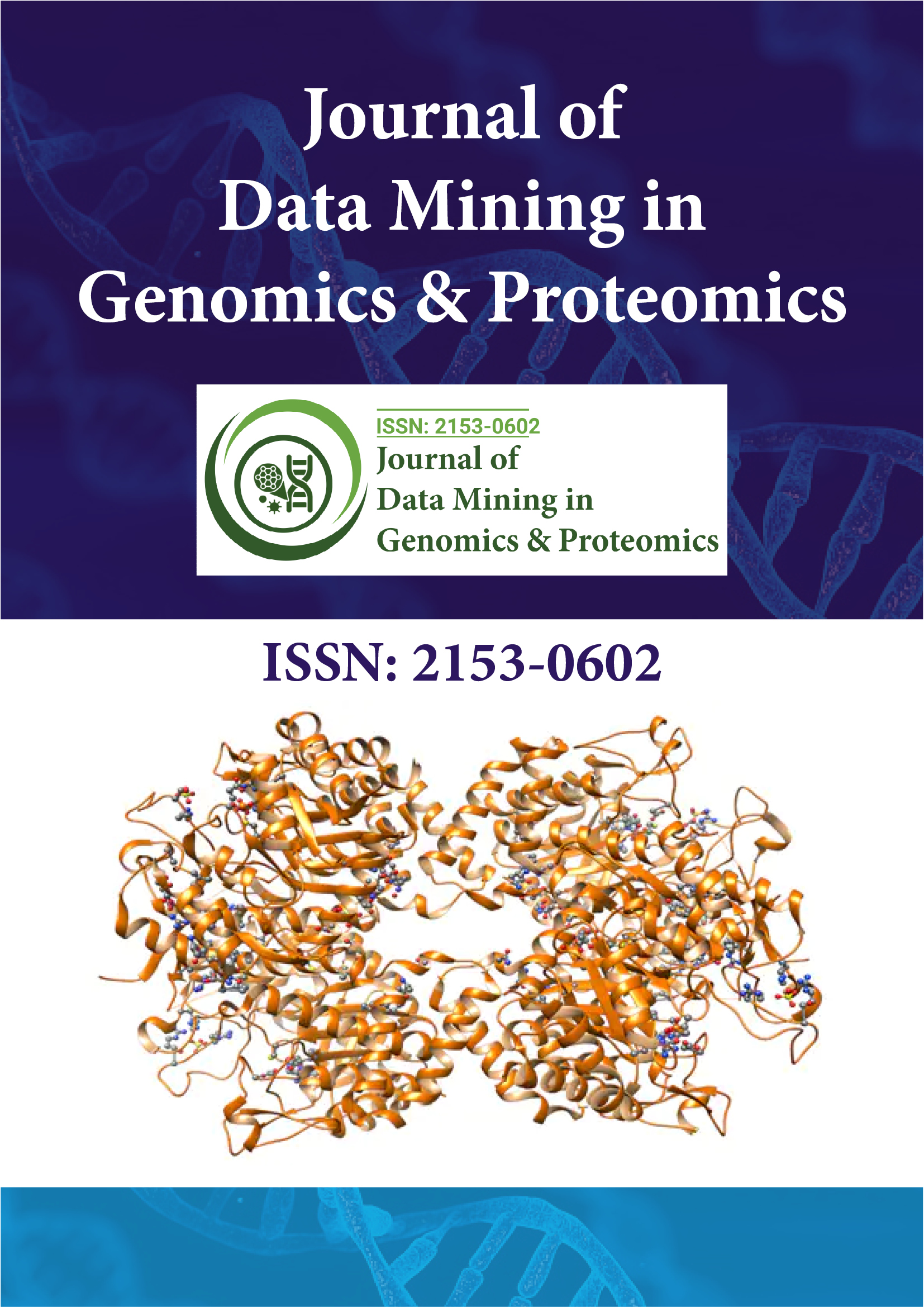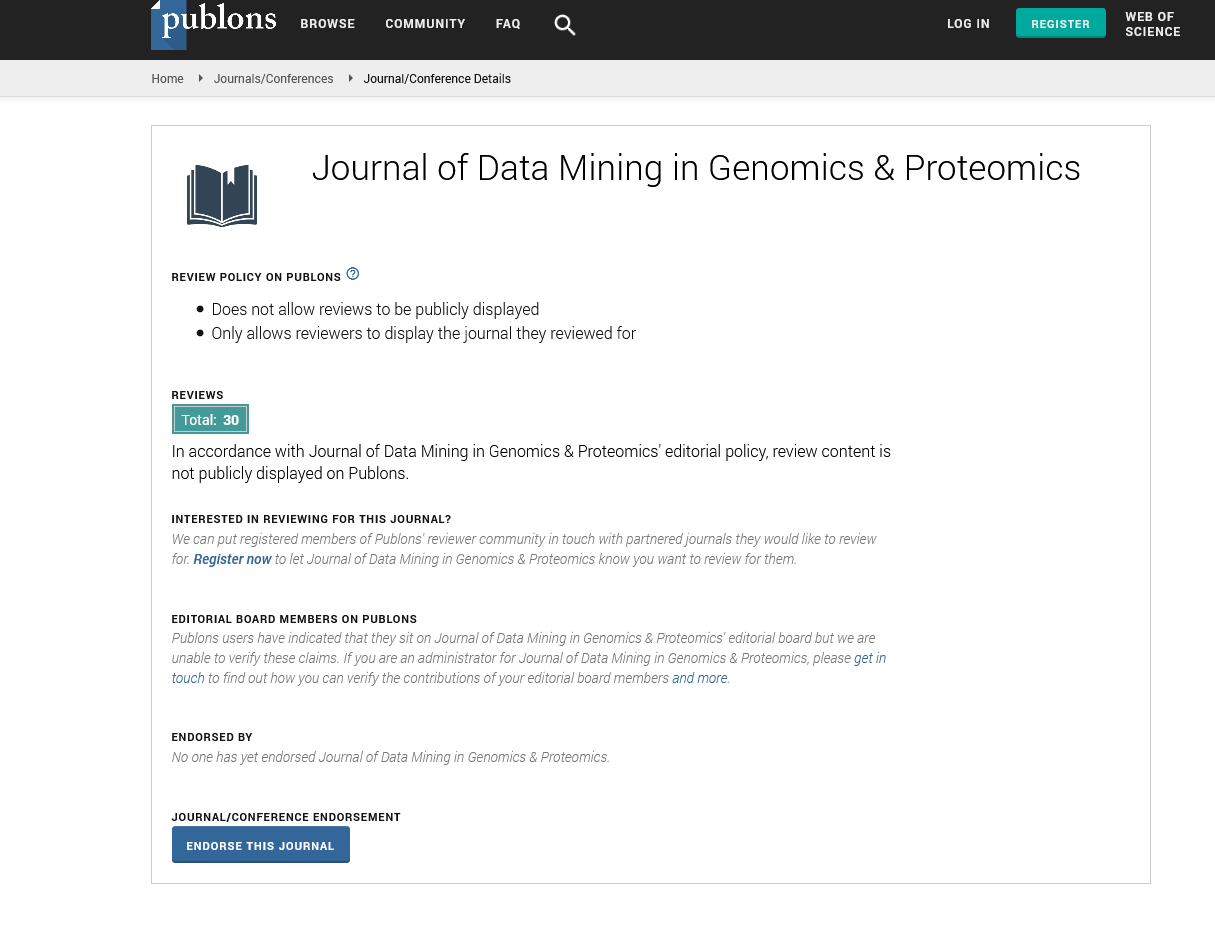Indexed In
- Academic Journals Database
- Open J Gate
- Genamics JournalSeek
- JournalTOCs
- ResearchBible
- Ulrich's Periodicals Directory
- Electronic Journals Library
- RefSeek
- Hamdard University
- EBSCO A-Z
- OCLC- WorldCat
- Scholarsteer
- SWB online catalog
- Virtual Library of Biology (vifabio)
- Publons
- MIAR
- Geneva Foundation for Medical Education and Research
- Euro Pub
- Google Scholar
Useful Links
Share This Page
Journal Flyer

Open Access Journals
- Agri and Aquaculture
- Biochemistry
- Bioinformatics & Systems Biology
- Business & Management
- Chemistry
- Clinical Sciences
- Engineering
- Food & Nutrition
- General Science
- Genetics & Molecular Biology
- Immunology & Microbiology
- Medical Sciences
- Neuroscience & Psychology
- Nursing & Health Care
- Pharmaceutical Sciences
Short Communication - (2022) Volume 13, Issue 3
The Role of Spatial Genomics in Subcellular Human Tissue
Giyeon Yang*Received: 02-May-2022, Manuscript No. JDMGP-22-17232; Editor assigned: 04-May-2022, Pre QC No. JDMGP-22-17232 (PQ); Reviewed: 18-May-2022, QC No. JDMGP-22-17232; Revised: 25-May-2022, Manuscript No. JDMGP-22-17232 (R); Published: 02-Jun-2022, DOI: 10.4172/ 2153-0602.22.13.256
Description
Intracellular heterogeneity plays an important role in cellular physiology and, in some debilitating diseases, cellular pathophysiology. This is greatly influenced by distinct organelle populations, and in order to understand disease a etiology, tools that can isolate and differentially analyze organelles from precise locations within tissues are required. We present the development of a subcellular biopsy technology that facilitates the isolation of organelles from human tissue, such as mitochondria. We compared subcellular biopsy technology to Laser Capture Micro Dissection (LCM), the current gold standard for isolating cells from their surrounding tissues. We show that LCM has an operational limit of (>20 m) and then show that subcellular biopsy can be used to isolate mitochondria beyond this limit in human tissue for the first time [1].
Inter-tissue and inter-cellular heterogeneity is thought to play a role in a variety of human diseases, including cancer, cardiovascular disease, metabolic disease, neurodegeneration, neurodevelopmental disorders, and pathological ageing. However, assessing heterogeneity at the tissue and cellular levels can frequently obscure subtle subcellular and organelle heterogeneity. In addition to the morphological and functional heterogeneity seen in other organelles, mitochondria exhibit genetic heterogeneity as a result of their own multi-copy genome. The Mitochondrial DNA (mtDNA) exists as uniform wild-type molecules at birth in healthy individuals, a condition known as homoplasmy, but de novo mutations result in a mixture of wildtype and mutant mtDNA molecules, a condition known as heteroplasmy [2].
While low-level heteroplasmy is well tolerated, the accumulation and spread of mutant mtDNA molecules above a certain threshold can result in impaired oxidative phosphorylation, which frequently leads to mitochondrial disease. The mechanism underlying this process, known as clonal expansion, is unknown. Investigating clonal expansion at the subcellular level may help us better understand the mechanisms underlying it and help characterize mitochondrial disease. More broadly, better understanding the physiological (and pathophysiological) relevance of intracellular organelle heterogeneity with subcellular precision would likely aid effective disease diagnosis and treatment; however, we need the appropriate technologies to achieve this. To take full advantage of single-cell multiomics, nano probe-based technologies can circumvent common challenges associated with investigating subcellular molecules, such as: Nano probe technologies are typically combined with scanning probe microscopy to enable nanometer-level precision in and around cells. As a result, the relatively small probe size allows for sampling from live cells while having little impact on cell viability or the cellular environment. Nano probe technologies are typically combined with scanning probe microscopy to enable nanometer-level precision in and around cells. As a result, the relatively small probe size allows for sampling from live cells while having little impact on cell viability or the cellular environment. Here the colleagues developed nano biopsy technology in 2014, which uses a nano pipette containing an organic solvent to aspirate mRNA and mitochondria from cultured fibroblasts' cytoplasm. This method is based on electro wetting, a process in which a liquid-liquid interface is manipulated by applying a voltage to aspirate a target from a living cell's cytoplasm. Fluid Force Microscopy (FFM), di electrophoretic nano tweezers, and nano pipettes have recently been used successfully to sample cytoplasmic proteins and nucleic acids from cultured cells [3,4].
Fluid Force Microscopy (FFM), di electrophoretic nano tweezers, and nano pipettes have recently been used successfully to sample cytoplasmic proteins and nucleic acids from cultured cells. However, none of these technologies have been used to investigate tissue samples used in clinical and molecular pathology. The goal of this study was to see if nano biopsy could be adapted for sampling from human tissue samples. We show that an adaptation of nano biopsy, subcellular biopsy, has the potential to go beyond conventional methodological limits by using Laser-Capture-Micro Dissection (LCM), the most commonly used approach for studying single cells from tissue samples, as a comparator [5,6].
Conclusion
We demonstrated in this study that a micropipette integrated within a SICM can successfully sample mitochondria from human skeletal muscle, or any human tissue, with a spatial resolution greater than the gold standard LCM. This technology, we believe, will allow for the isolation and analysis of organelle populations from discrete foci within tissues for downstream molecular and structural analysis.
REFERENCES
- Chouchane L, Boussen, H, Sastry KS. Breast cancer in Arab populations: molecular characteristics and disease management implications. Lancet Oncol. 2013;14(10):e417-424.
[Crossref] [Google Scholar] [PubMed]
- Kuchenbaecker KB, Hopper JL, Barnes DR, Phillips KA, Mooij TM, Roos-Blom MJ, et al. Risks of breast, ovarian, and contralateral breast cancer for BRCA1 and BRCA2 mutation carriers. JAMA. 2017;317(23):2402-2416.
[Crossref] [Google Scholar] [PubMed]
- Grindedal EM, Heramb C, Karsrud I, Ariansen SL, Maehle L, Undlien DE, et al. Current guidelines for BRCA testing of breast cancer patients are insufficient to detect all mutation carriers. BMC Cancer. 2017;17(1):438.
[Crossref] [Google Scholar] [PubMed]
- McCarthy AM. Persistent underutilization of BRCA1/2 testing suggest the need for new approaches to genetic testing delivery. J Natl Cancer Inst. 2019;111(8):751-753.
[Crossref] [Google Scholar] [PubMed]
- Corsini C, Henouda S, Nejima DB, Bertet H, Toledano A, Boussen H, et al. Early onset breast cancer: differences in risk factors, tumor phenotype, and genotype between North African and South European women. Breast Cancer Res Treat. 2017;166(2):631-639.
[Crossref] [Google Scholar] [PubMed]
- Mavaddat N, Antoniou AC, Easton DF, Garcia-Closas M. Genetic susceptibility to breast cancer. Mol Oncol. 2010;4(3):174-191.
Citation: Yang G (2022) The Role of Spatial Genomics in Subcellular Human Tissue. J Data Mining Genomics Proteomics. 13:256.
Copyright: © 2022 Yang G. This is an open-access article distributed under the terms of the Creative Commons Attribution License, which permits unrestricted use, distribution, and reproduction in any medium, provided the original author and source are credited.

